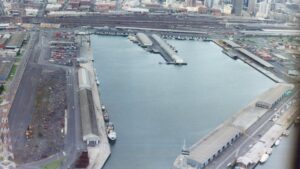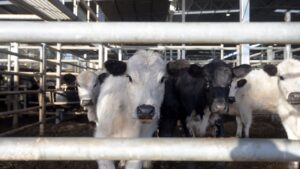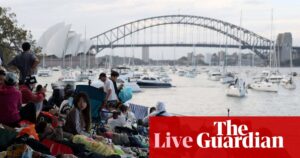
If nothing else, Peter Dunn knows how to gauge a threat. In 1970, he was shot down in a helicopter near Long Hai in South Vietnam during a reconnaissance mission while serving as a military adviser to the 302 Regional Force Battalion. In 2003, he was among the firefighters in Canberra who fought the blaze that took four lives and 470 homes. It was the first time a fire tornado was documented to have occurred in Australia. In 2019, he was at Lake Conjola when one of the most savage fires of that awful summer hit the village. By the time it passed, 89 homes had been lost.
Fire supercharged by extreme weather scares him more than combat, says Dunn, who retired from the army as a major general and went on to serve as commissioner of the ACT’s Emergency Service Authority. “Those fires are the most horrifying things that I’ve been through,” says Dunn, now a member of Emergency Leaders for Climate Action. “In a combat situation, you’re surrounded by people in uniform, generally, and you’re armed, and you’re trained, and you’ve got plans, and you’ve got actions you take. When we were hit, both in Canberra and in Lake Conjola, we’re surrounded by people who were community members. They were the bakers, the farmers, the pharmacists, [people with] no experience with this whatsoever, and you did not have that cohesive structure around you.”
Australia’s New Climate Targets
Last year, Dunn was one of the 250 scientists and experts called on to contribute to the Climate Risk Assessment Report the government released on Monday, part of a carefully choreographed lead-up to its announcement on Thursday of the new 2035 emissions reduction targets Australia will submit next week at the UN General Assembly as a signatory to the Paris Agreement.
These targets, known in UN jargon as Nationally Determined Contributions, are at the very heart of the global effort to hold warming to under 2 degrees and as close as possible to 1.5 degrees. Under the terms of the treaty, each country must set its own target and update it every five years. The agreement acknowledges that advanced economies like Australia must move faster than those still developing. It is a cumbersome and complex system that demands the ongoing political will and engagement of every nation signed up to the effort.
The process recognises that no single country can address global warming alone, and it seeks to ensure that the burden of doing so is shared fairly. Clearly, if the Albanese government was going to call for a national effort to remake the entire economy in a single decade, it was going to need political support and, for that, it would need to again explain to Australians why it was necessary, which brings us back to Dunn and the risk assessment report.
Understanding the Climate Risk Assessment
The report laid out the impact on Australia of global warming at 1.5 degrees, 2 degrees, and 3 degrees. The outlook is grim. In releasing the document, Climate Change and Energy Minister Chris Bowen said: “It’s important that we don’t gild the lily or downplay its impact in any way. We have to be honest with the Australian people.”
Bowen described the impact of climate change as now inevitable due to the amount of carbon dioxide already released into the atmosphere. The changes would hit every sector of society and the economy in waves that were “cascading, compounding and concurrent”, he said. Those impacts include a spike in the incidence and intensity of drought, an expanded threat of bushfire, flood and coastal inundation, an escalation in disaster costs, a decline in agricultural production, damage to infrastructure, and disruption of supply chains.
“It’s too late to avoid any impacts, but it’s not too late to avoid the worst of the impacts,” said Bowen. “As the report makes clear, the difference in terms of impact between 1.5 and 2 degrees of warming, let alone 3, is very real for Australia. So hence, our efforts on mitigation must and will continue.”
According to Dunn, the assessment is, if anything, a conservative reflection of the views of the contributors. He describes a process in which experts in various fields attended workshops hosted by the CSIRO to present evidence about predicted climate impacts. Dunn contributed to the areas of national security and defence. Once the workshops began, the views and opinions put forward were tested.
Setting Ambitious Targets
On Thursday, Anthony Albanese hosted a press conference at the Commonwealth Parliament Office in Bligh Street, flanked by Treasurer Jim Chalmers, Bowen, and Matt Kean, chair of the Australian Climate Change Authority, which was charged with drafting advice to the government on what Australia’s updated climate target should be. “I announce that we have accepted their advice that Australia’s 2035 emissions target be 62 to 70 per cent. This is a responsible target, backed by the science, backed by a practical plan to get there and built on proven technology,” he said.
Climate analysts were unimpressed. “It’s worse than I feared,” Bill Hare, a physicist and one of the leaders of the global climate action monitoring think tank Climate Analytics, told this masthead via text at once. “No climate scientist on the planet would say this target aligns with limiting warming [to] 1.5 degrees,” texted Dr Simon Bradshaw, a climate researcher with environmental activist group Greenpeace.
Asked about this, Bowen bristled. The Climate Change Authority did as it had been instructed – it recommended to the government the maximum level of achievement possible. “And that maximum level of achievement possible, based on all the analysis and modelling, is exactly the target they’ve recommended, 62 to 70, and exactly what we’ve accepted.”
The Path Forward
For the government to hit the target range it announced this week, it will need to double Australia’s current emission reductions. It will require increasing the level of renewables in the grid to 97 per cent by 2050, while increasing EV sales to half of all new vehicles by 2035, while ramping up energy storage by sixfold and cutting industrial emissions by about a third.
“It’s the equivalent of taking the transport emissions out of Australia twice over the next 10 years,” Bowen told ABC TV’s 7.30 on Thursday evening. “We are going to need a Team Australia moment. We’re going to need to be all in,” he said in a press conference on Friday morning.
Grattan Institute energy and climate change fellow Tony Wood says the further we get into the transition, the harder it is becoming. Bowen is right when he says wind and solar is now the cheapest form of electricity humans have ever generated, says Wood, but storing and moving the stuff about is proving to be more complicated and expensive than the government anticipated even a few years ago. As planning departments confront irate landholders, costs keep going up.
And the numbers get even more magical when you start wading through the Net Zero Plan, also released by the government this week. (Under the Paris Agreement, the government is committed to reaching net zero emissions by 2050.) In one section, the authors say: “Regardless of how effectively we reduce emissions, all available analysis indicates our economy will still be emitting greenhouse gases in 2050 – carbon removals are a critical part of reaching net zero. New carbon removal technologies will be increasingly important as 2050 approaches, but most need further development before they will be ready to be deployed at scale.”
The comfortingly bland bureaucratese of the document washes over an alarming truth. This technology does not yet exist. Even if everything goes right in the government’s plans, due to years of delay acting on climate, we cannot hope to meet the Paris goal without deploying as-yet-undeveloped technology to extract carbon dioxide from the atmosphere, at scale, to bury in as-yet-unidentified underground caverns in as-yet-undiscovered processes. This is a truth also buried in the UN’s models.
On Friday, McKenzie was careful not to dismiss the government’s efforts. She cast the lower end of the government’s target range as way too low, but she said 70 per cent was achievable and, with effort, the nation might build up on it. “It’s a conservative target, but we expect more policies to be announced,” she says. According to McKenzie, every tonne of carbon prevented from reaching the atmosphere and every tenth of a degree of warming spared will save lives and money. While she would have liked to have seen a higher target – particularly a higher minimum – she reserves more criticism for the opposition, whose leader, Sussan Ley, has announced a review of climate policy as she seeks to dampen internal warfare over the issue.
“Not having a policy is a policy,” says McKenzie. “It is a policy to let climate change rip.”
The vast and increasing difficulty of the rapid transition is no excuse not to act, says Wood. “It’s not like the choice we have is to either attempt this or give up on this. The climate is not negotiating with us. Our only real choice is to do it well or do it badly.”






